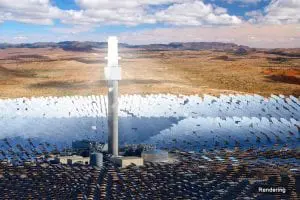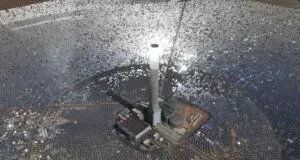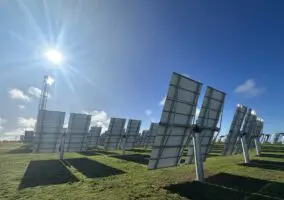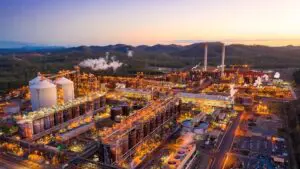South Australia continues to build on its track record of pioneering cutting edge renewable energy technologies, as the components of a world-leading, Adelaide-made molten silicon energy storage system make their way to their destination at a waste-water treatment plant.
The ambitious $3.2 million pilot project is a joint effort of the ASX-listed innovator behind the thermal storage system, 1414 Degrees, and SA Water, and is being co-funded by the state government’s Renewable Technology Fund ($1.6m).
The so-called GAS-TESS (TESS stands for Thermal Energy Storage System) will be installed at SA Water’s Glenelg wastewater treatment plant, where it will store energy by burning gases produced in the treatment process and generate heat and electricity for the plant.
The system it is designed to replace generates up to 80 per cent of the plant’s electricity but is very expensive to operate and does not provide energy
storage for peak demand.
For SA Water, the project marks another bold move towards its zero net energy target of 2020, which kicked off last year with a tender to install 100kW solar and 50kWh battery storage at its Crystal Brook Workshop site.
For 1414 Degrees, the partnership offers a way for the recently listed company to test the ability of its molten silicon technology to integrate energy storage and heat with industrial operations – a huge potential market.
As reported here, the company has spent almost a decade developing its TESS technology to store electricity as thermal energy by heating and melting containers full of silicon, at a cost they say could be up to 10 times cheaper than lithium-ion batteries.
Originally, the TESS was developed with a focus on electrical input, such as solar or wind power, as well as on utility-scale systems.
The company has flagged plans to build two grid-scale 1GWh systems in South Australia, each made up of five 200MWh units, and to test them in the role of helping to stabilise the state’s majority renewables electricity network.
The 10MWh GAS-TESS unit was engineered especially by 1414 Degrees, in response to a request from SA Water to create a storage system with a biogas input.
Dr Kevin Moriarty, executive chairman of 1414 Degrees, said the trial at Glenelg was an important step in demonstrating the technology’s ability – and its potential in commercial industrial operations beyond just energy storage.
“There is a much bigger requirement for heat energy than for electric energy in the world, and particularly in industry,” Moriarty told RenewEconomy in an interview on Wednesday.
“Batteries are no use at all in that context.”
“We do a different thing to batteries (and pumped hydro) in that we store electricity, or burn biogas, to regenerate heat and electricity,” he said.
Indeed, the SA Water pilot neatly showcases some other key benefits of molten silicon storage, including a flexibility of location that means it can be built to the scale of pumped hydro, but located where useful, instead of near hills or dams.
“We expect to commission the GAS-TESS in March 2019 and provide immediate returns for SA Water, while at the same time building a foundation for the wider application of the 1414 Degrees technology at similar sites across the globe,” said Moriarty.
“It’s our view that this device will be the first significant revenue driver for the company. It’s got worldwide application, there’s nothing like it, and it will lead to the generation of much more power from biogas,” which he notes, is currently a comparatively expensive and inefficient renewable energy resource, on its own.
“Our timing could not be better, with an increasing focus on the critical importance of renewable energy to ensuring a sustainable future for Australia.”
Interestingly the timing also coincides with this week’s news of a breakthrough on molten silicon storage technology by a team at the Massachusetts Institute of Technology in the US.
In this case, while the basic function of the technology is the same, the MIT team claims to have found a way to heat the silicon to “white hot” temperatures of 4000°F (2200°C), without compromising the storage tanks or pumps.
But while laboratory-scale testing to prove this out appears to have been successful, the team’s energy storage system remains at the design phase, only.
Comparatively, 1414 Degrees – its eponymous TESS heats the molten silicon to a temperature of 1414°C – appears to be making good progress, since going public at the end of 2016, and then listing on the ASX in September this year.
During that time, around $30 million has been invested in the company, including $16.3 million that was raised in its Initial Public Offering (IPO).
In April of this year, it inked a deal to install a 25MWh demonstration of its TESS technology to provide electricity and heat for the NSW processing plant of Australian poultry farmer Pepe’s Ducks.
And there are bigger plans afoot. Moriarty says the company has been exploring trials of its grid scale 200MWh TESS modules with some “quite large utilities and power plants” in Australia, Europe and in North America.
“We’re going through a process of joint assessment with these utilities and plant types, looking at a range of possibilities,” he told RE. “Some are existing power plants that want to incorporate storage to obtain greater efficiencies… Other possibilities include tying the (storage systems) in directly to large renewable generation.”
And Moriarty says 1414 Degrees is also planning to provide, itself, an integrated renewable energy and storage solution to a number of companies.
“We’re pursuing that actively at the moment,” he said.
“But in the meantime, we’re very keen on providing this sort of heat and power solution to commercial industries.”
SA Water chief Roch Cheroux said it was exciting that local innovation was being coupled with an essential service and driving its push for a zero cost energy future.
“Embracing innovative, world-leading technology and ways of thinking, is essential to reducing our electricity costs and maintaining low and stable pricing for our customers,” Cheroux said.
“As well as realising the benefits of increased energy self-sufficiency, we can support South Australian innovation and, hopefully, lead a global charge to reduce the costs and environmental impacts of energy-intensive wastewater treatment operations.”










